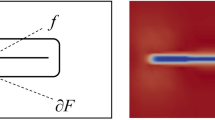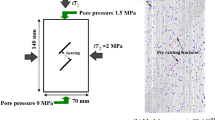Abstract
The models of stress corrosion, pressure solution and free-face dissolution/precipitation were introduced. Taking a hypothetical nuclear waste repository in an unsaturated dual-porosity rock mass as the calculation objective, four cases were designed: 1) the fracture aperture is a function of stress corrosion, pressure solution and free-face dissolution/precipitation; 2) the fracture aperture changes with stress corrosion and pressure solution; 3) the fracture aperture changes with pressure solution and free-face dissolution/precipitation; 4) the fracture aperture is only a function of pressure solution, and the matrix porosity is also a function of stress in these four cases. Then, the corresponding two-dimensional FEM analyses for the coupled thermo-hydro-mechanical processes were carried out. The results show that the effects of stress corrosion are more prominent than those of pressure solution and free-face dissolution/precipitation, and the fracture aperture and relevant permeability caused by the stress corrosion are only about 1/5 and 1/1000 of the corresponding values created by the pressure solution and free-face dissolution/precipitation, respectively. Under the action of temperature field from released heat, the negative pore and fracture pressures in the computation domain rise continuously, and are inversely proportional to the sealing of fracture aperture. The vector fields of flow velocity of fracture water in the cases with and without considering stress corrosion are obviously different. The differences between the magnitudes and distributions of stresses within the rock mass are very small in all cases.
Similar content being viewed by others
References
TARON J, ELSWORTH D. Thermal-hydrologic-mechanical-chemical processes in the evolution of engineered geothermal reservoirs [J]. International Journal of Rock Mechanics and Mining Sciences, 2009, 46(5): 855–864.
AIFANTIS E. On the problem of diffusion in solids [J]. Acta Mech, 1980, 37: 265–296.
TARON J, ELSWORTH D. Coupled mechanical and chemical processes in Engineered geothermal reservoirs with dynamic permeability [J]. International Journal of Rock Mechanics and Mining Sciences, 2010, 47(8): 1339–1348.
NARA Y, KANEKO K. Study of subcritical crack growth in andesite using the double torsion test [J]. Int J Rock Mech Min Sci, 2005, 42(4): 521–530.
YASUHARA H, ELSWORTH D. Evolution of permeability in a natural fracture: Significant role of pressure solution [J]. J Geophys Res, 2004, 109: B03204, doi:10.1029/2003JB002663.
DREYBRODT W, BUHMANN D. A mass transfer model for dissolution and precipitation of calcite from solutions in turbulent motion [J]. Chem Geol, 1991, 90: 107–122.
DOVE M. Geochemical controls on the kinetics of quartz fracture at subcritical tensile stresses [J]. J Geophys Res, 1995, 100(B11): 22349–22359.
YASUHARA H, ELSWORTH D. Compaction of a rock fracture moderated by competing roles of stress corrosion and pressure solution [J]. Pure Appl Geophys, 2008, 165: 1289–1306.
TENTHOREY E, COX S, TODD H. Evolution of strength recovery and permeability during fluid-rock reaction in experimental fault zones [J]. Earth and Plane Sci Lett, 2003, 206: 161–172.
LIN W, ROBERTS J, GLASSLEY W, RUDDLE D. Fracture and matrix permeability at elevated temperatures [R]. Workshop on Significant Issures and Available Data, Near-field/Altered-zone Coupled Effects Expert Elicitation Project, San Francisco, 1997.
DURHAM W, BOURCIER W, BURTON E. Direct observation of reactive flow in a single fracture [J]. Water Resour Res, 2001, 37: 1–12.
LIU X, ORMOND A, BARTKO K, LI Y, ORTOLEVA P. A geochemical reaction-transport simulator for matrix acidizing analysis and design [J]. Pet Sci Eng, 1997, 17: 181–196.
DIJK P, BERKOWITZ B. Buoyancy-driven dissolution enhancement in rock fractures [J]. Geology, 200, 28(11): 1051–1054.
PALMER A. Origin and morphology of limestone caves [J]. Geol Soc Am Bull, 1991, 103: 1–21.
POLYAK V, MCINTOSH W, GÜVEN N, PROVENCIO P. Age and origin of Carlsbad cavern and related caves from 40Ar/39Ar of alunite [J]. Science, 1998, 279: 1919–1922.
YASUHARA H, ELSWORTH D, POLAK A, LIU J, GRADER A, HALLECK P. Spontaneous switching between permeability enhancement and degradation in fractures in carbonate: Lumped parameter representation of mechanically-and chemically-mediated dissolution [J]. Transport in Porous Media, 2006, 65: 385–409.
DAVIS J, DAVIS D. Stress-dependent permeability: Characterization and modeling [R]. Society of Petroleum Engineers, SPE Paper no. 56813, 1999.
ZHANG Yu-jun. Coupled thermo-hydro-mechanical model and finite element analyses of dual-porosity fractured medium for ubiquitous-joint rock mass [J]. Chinese Journal of Rock Mechanics and Engineering, 2009, 28(5): 947–955. (in Chinese)
ZHANG Yu-jun, ZHANG Wei-qing. Finite element analysis of influence of pressure solution of fracture aperture on T-H-M coupling in dual-porosity medium [J]. Rock and Soil Mechanics, 2010, 31(4): 1269–1275. (in Chinese)
OLSSON R, BARTON N. An improved model for hydromechanical coupling during shearing of rock joints [J]. Int J Rock Mech Min Sci, 2001, 38(3): 317–329.
ZHOU Wei-yuan. Advanced rock Mechanics [M]. Beijing: Hydranlic and Electric Power Press, 1990: 276–282.
Author information
Authors and Affiliations
Corresponding author
Additional information
Foundation item: Project(2010CB732101) supported by the National Basic Research Program of China; Project(51079145) supported by the National Natural Science Foundation of China; Project(2009BAK53B03) supported by the National Key Technology R&D Program of China
Rights and permissions
About this article
Cite this article
Zhang, Yj., Yang, Cs. FEM analyses for influences of stress-chemical solution on THM coupling in dual-porosity rock mass. J. Cent. South Univ. Technol. 19, 1138–1147 (2012). https://doi.org/10.1007/s11771-012-1120-4
Received:
Accepted:
Published:
Issue Date:
DOI: https://doi.org/10.1007/s11771-012-1120-4




